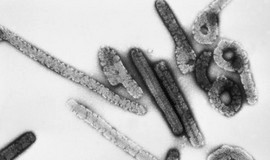Marburg virus is the virus that causes Marburg hemorrhagic fever (MHF). When referring to hemorrhagic fevers, you cannot help but feel scared because they are highly contagious with high mortality rates and Marburg hemorrhagic fever is no exception.
The year 1967 marked the discovery of Marburg virus during the simultaneous outbreaks that occurred at the laboratories in Frankfurt and Marburg, Germany as well as in Belgrade, Yugoslavia (now called Serbia). The outbreak happened when a disease agent arrived with African green monkeys imported from Uganda. These monkeys are used for research and preparation of polio vaccine. People exposed to these monkeys and to their tissues were infected with the virus. They included laboratory workers, medical staffs and nursing family members. In the 1967 outbreak, a total of 31 reported cases contracted the virus, of which 7 died. Since then, there were reported periodic small outbreaks. But it was not until 2004 to 2005 where a major outbreak of Marburg virus occurred in Angola resulting to over 140 deaths.
About Marburg Virus
The virus shares similar structure and shape with the Ebola virus but differs in the sense that Marburg virus promotes the production of diverse antibodies. Both viruses primarily cause hemorrhagic fevers characterized by sever hemorrhage or bleeding, organ failure and even death. Moreover, they both originate in Africa where reported cases of Marburg hemorrhagic fever occurred in Kenya, Zimbabwe, Angola and Uganda. Animals are the hosts of these viruses and later on transmitted to humans. The virus then spread from one person to another when exposed to bodily fluids of the infected person such as the saliva, vomit, feces, blood and even contaminated needles. The incubation period of the virus usually ranges from 3 to 10 days. Unfortunately, there is no known cure for this virus and people infected with it usually receive treatment for the complications and supportive care.
What are the Causes and Risk Factors?
People who are exposed to humans or animals infected with Marburg viruses are at high risk. Recent scientific findings reveal that aside from African green monkeys, Egyptian fruit bats residing in African caves are reservoir host of Marburg viruses. On the other hand, persons working in laboratories and quarantine facilities are prone to contract the virus. Besides, caring family members and hospital personnel handling patients with Marburg hemorrhagic fever are at high risk if they fail to use proper nursing techniques. The virus can easily spread through bodily fluids and aerosols of small droplets of splutter and cough from infected persons.
What are the Symptoms?
Symptoms are hardly noticeable during the ten-day incubation period of the virus. After which, patients will experience sudden onset of symptoms which include flu-like symptoms such as fever, headache, aching muscles, vomiting, chills and nausea. Over time, the condition will aggravate resulting to bloody diarrhea, rashes, stomach pain, extensive weight loss, cough, red eyes, aggression, confusion and severe bleeding on the ears, eyes, mouth, nose and rectum.
What are the Complications of Marburg Virus?
Marburg hemorrhagic fever can be very damaging resulting to delirium, shock, seizures, jaundice, severe bleeding, coma, organ failure and death. Death usually occurs in not later than 10 days after commencement of the manifestations of symptoms. In localities where medical services are poor, mortality rate is higher. Besides, diagnosis of the disease is difficult because it shares similar signs and symptoms to other diseases like typhoid fever and malaria.
How is Marburg Virus Treated?
Until now, there are no known antiviral medications to treat the virus infection. Consequently, treatment procedures primarily consists of supportive hospital therapy which involves balancing the electrolytes and fluid level of the patient by administration of intravenous fluids, maintaining proper blood pressure and oxygen level, replacement of blood loss and treatment of complicating infections. When necessary, plasma transfusions are done to replenish the loss of blood proteins essential in clotting. However, Marburg virus reacts to detergents, phenolic and hypochlorite disinfectants as well as lipid solvents. The virus can be destroyed by gamma and ultraviolet radiation.
Marburg Virus Pictures
How long is the Recovery Period?
Patients who get to survive the 10-day period of symptoms will start to recover. However, it may take five weeks or more for the person to fully bounce back from the condition characterized by prostration, amnesia and weight loss. Complications may also occur during this time which includes swelling of parotid gland, testes, bone marrow, spinal cord and eyes as well as recurring hepatitis.
Can it be prevented?
With regards to transmission from the original host, preventive measures have not yet been established. However, something can be done against secondary transmission. When there is an outbreak, strict hygiene helps in preventing the spread of the virus. Frequent hand washing is one way of stopping the spread of the disease. If possible, avoid physical contact with people infected by the virus and traveling to areas where an outbreak is occurring. Moreover, follow infection-control preventive measures if you work in health care facilities by wearing the appropriate protective clothing which includes masks, eye shields, gowns and gloves. Besides, infected people must be quarantined in negative-pressure facilities while used syringes and needles must be disposed of properly. Lastly, don’t personally handle the corpse of anyone suspected to die from Marburg hemorrhagic fever. There are specially-trained people to handle and bury them using proper safety equipment.
Further Considerations
Although vaccines are not yet available, several vaccines are currently tested. If you plan to travel in areas where there is an outbreak, knowing the latest update of the outbreak and health advisories which are readily available online is an advantage. Although Marburg hemorrhagic fever rarely strikes, it has the possibility to contract other people easily, most especially health care providers. Thus, increasing the awareness of this condition is crucial to help everyone take precautionary measures against contracting the infection and spreading to other people.
Full understanding about Marburg hemorrhagic fever is only possible when the reservoir and ecology of Marburg virus are documented. Besides, the bearing of the disease will remain unclear not until the definite occurrence of the Marburg hemorrhagic fever and endemic localities are fully determined.

